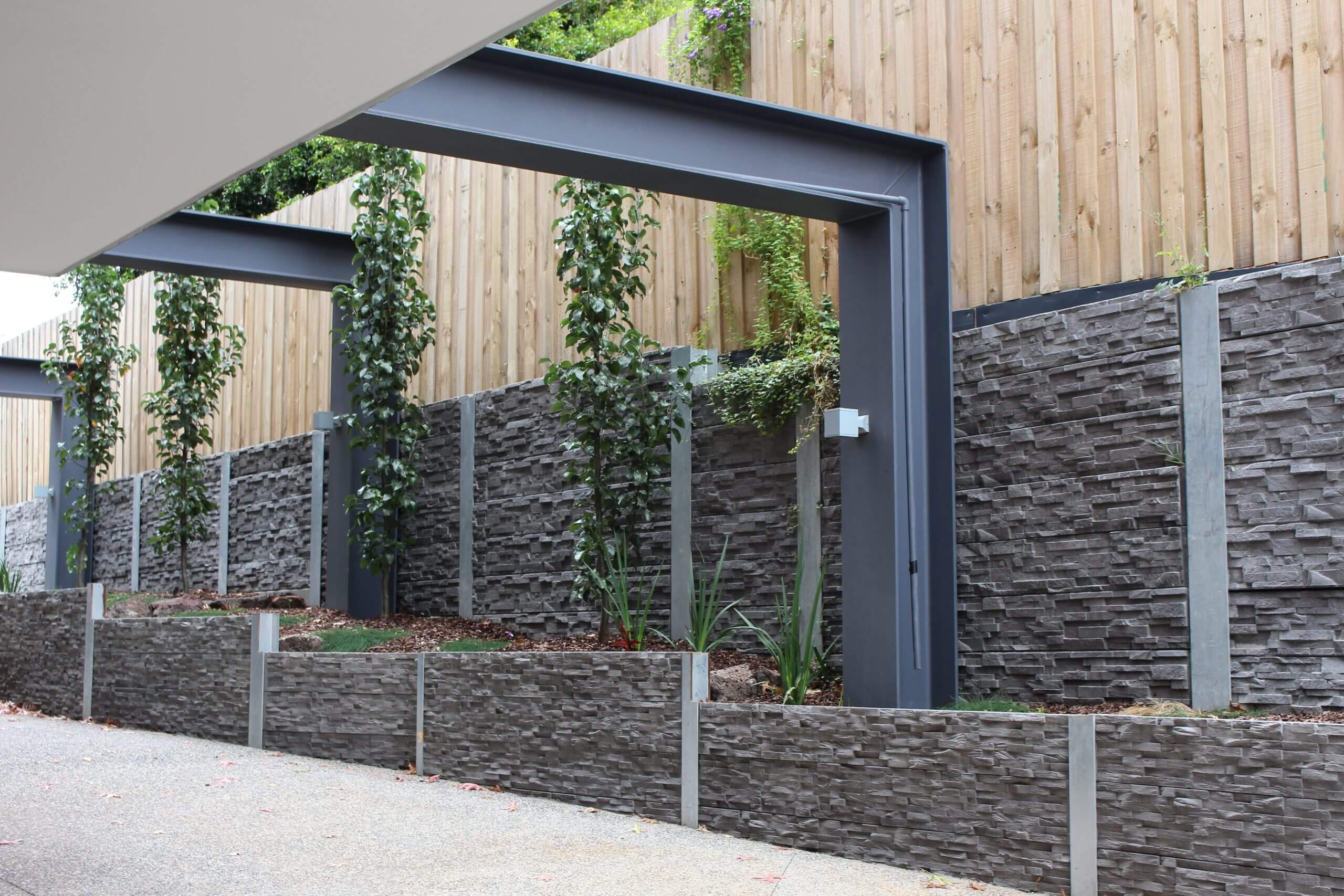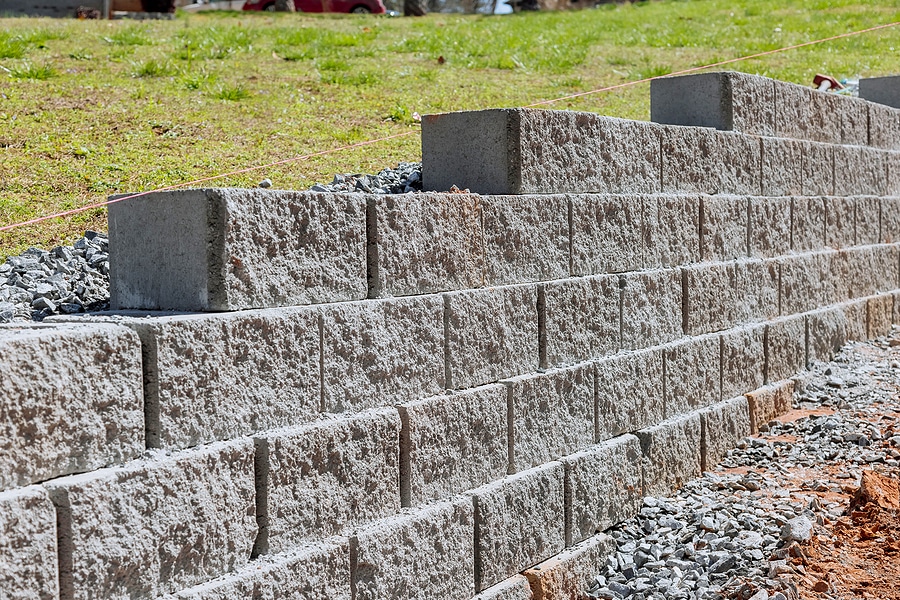Secret Considerations for Structure Efficient Retaining Walls in Your Backyard
When you're considering developing a keeping wall in your yard, it's essential to consider numerous vital aspects. The wall's purpose, the products you'll use, and the certain dirt conditions can all affect its effectiveness and long life. You'll additionally require to browse neighborhood building codes and prepare for proper drain. Just how do you assure your design not only fulfills these needs yet also enhances your landscape? Allow's discover the essential steps together.
Comprehending the Objective of Your Retaining Wall
When you think of constructing a maintaining wall, consider its major objective: maintaining dirt and stopping erosion. Retaining walls offer important support for sloped landscapes, aiding to preserve dirt integrity. You'll find they're crucial in areas where water overflow could or else wash away soil, causing pricey repair work and landscape damage.
By keeping back planet, these walls produce level surface areas for yards, patio areas, or paths. This not just enhances your backyard's looks yet likewise promotes better water drainage, lowering water pooling in undesirable locations. If you're taking care of high inclines, a sound retaining wall surface can protect against landslides, making certain safety and security for you and your residential or commercial property.
Eventually, comprehending the purpose of your retaining wall surface will certainly lead your design decisions and help you produce a useful, long lasting structure that meets your needs. Take a moment to assess your landscape; it'll pay off in the long run.
Selecting the Right Products
When selecting products for your retaining wall, you'll intend to take into consideration toughness, aesthetics, and price. Each element plays a vital role in guaranteeing your wall surface stands the test of time while looking wonderful and suitable your spending plan. Let's check out exactly how to make the most effective choices for your task.
Product Sturdiness Variables
Picking the right materials is crucial for the durability and effectiveness of your retaining wall surface, since their resilience straight influences the wall surface's capacity to endure environmental anxieties. Begin by considering your local environment; products like concrete and stone withstand dampness and temperature level variations well. If you reside in a location prone to hefty rains, select materials with great drainage residential or commercial properties, like gravel or porous blocks, to stop water build-up.
Some materials execute far better in details soil types, so it's vital to match them accordingly. Picking durable products warranties your retaining wall stands solid, protecting your yard for years to come.
Aesthetic Layout Selections
Sturdy materials not just ensure your retaining wall surface's architectural honesty however additionally play an essential role in its aesthetic appeal. Don't forget about the wall's form-- rounded walls can produce a softer look, while straight lines can really feel more organized. By meticulously picking materials that align with your aesthetic vision, you'll enhance your exterior room while guaranteeing your wall stands strong versus the aspects.
Cost-Effectiveness Evaluation
Choosing the ideal materials for your retaining wall isn't just about visual appeals; it's likewise crucial for your budget. When choosing materials, consider both upfront expenses and lasting longevity.
Don't fail to remember to aspect in maintenance prices. Some products, like natural rock, can include beauty and call for less upkeep, while others could require routine treatments
Eventually, evaluate the benefits and drawbacks of each option versus your budget and the wall's intended objective. Spending carefully in materials now can protect against expensive issues in the future. Select products that stabilize expense and performance successfully.
Evaluating Dirt Problems and Drainage
As you start your job, examining soil conditions and water drainage is vital for the success of your retaining wall surface. Start by analyzing the type of dirt in your yard. Sandy soil drains well but lacks security, while clay soil can maintain dampness, leading to push on your wall surface. Test the soil's wetness content by digging a small opening and observing how swiftly it dries out.
Following, examine the slope of your yard. If water naturally streams toward your wall surface, you'll need to implement a drain solution to avoid disintegration and stress buildup. Consider installing perforated pipes or crushed rock backfill behind the wall to promote water drainage.
Last but not least, observe any kind of nearby trees or vegetation; their roots can impact dirt security. By recognizing your dirt problems and carrying out correct water drainage, you'll develop a solid structure for your retaining wall surface that stands the test of time.
Adhering To Local Building Ordinance
Prior to you start developing your retaining wall, you need to research local regulations to guarantee conformity. It's necessary to understand what allows you must get, as this can save you from costly penalties or having to remodel your work. Taking these actions seriously will assist you develop a risk-free and reliable structure.
Research Local Regulations
Understanding neighborhood policies is necessary when preparing your retaining wall surface task, particularly since developing codes can differ considerably by location. Look for guidelines on wall height, products, drainage systems, why not try here and architectural honesty. By doing your research study you could try these out upfront, you can ensure your retaining wall surface fulfills all necessary codes and blends effortlessly into your lawn.
Get Needed Permits
Once you have actually investigated regional policies, the following step is to acquire the needed authorizations for your retaining wall job. They might require specific plans or engineering analyses, especially for larger walls. Protecting the best authorizations can save you from costly penalties or having to dismantle your wall later on.

Preparation the Style and Looks
As you start preparing the style and appearances of your retaining wall surface, take into consideration how it will harmonize with the bordering landscape. Consider the materials you'll use-- rock, block, or concrete-- and just how they'll complement your home's style and the natural elements in your backyard. Pick colors and textures that mix effortlessly with existing functions like patio areas, paths, or yards.
Following, imagine the wall's shape and elevation. Curved walls can soften a rigid landscape, while straight lines may share a much more modern appearance. Don't fail to remember to integrate plants and greenery around the wall surface for a natural touch; this can boost its charm and incorporate it right into the setting.
Lastly, bear in mind performance. Your design should not only be aesthetically pleasing yet additionally serve its function properly. By thoughtfully planning these elements, you'll produce a preserving wall surface that improves your lawn's appeal while satisfying its structural function.
Calculating Elevation and Thickness Demands
To develop a durable retaining wall, you need to properly determine its elevation and thickness demands based on the dirt problems and the elevation of the slope it will certainly sustain. Begin by examining the incline's angle and the kind of soil, as different dirts exert varying amounts of pressure.
For walls over 4 feet high, think about a density of at the very least 12 inches. If the wall is taller, increase the density proportionally to maintain security.
Next, calculate the height of the wall by measuring the upright range it requires to keep. For each foot of height, you need to generally prepare for a thickness of one-third of the wall's height.
Constantly remember to account for added aspects like drainage and backfill, which can influence your wall surface's layout. Correct calculations currently guarantee your retaining wall stands strong and lasts for years to find.
Maintenance and Durability Considerations
While maintaining your retaining wall surface may feel like a reduced top priority, disregarding it can lead to substantial issues gradually. Normal my review here assessments are crucial; check for splits, protrudes, or any type of indicators of water damage. Resolving these problems early can conserve you from costly fixings down the roadway.
Watch on water drainage systems, too. Clogged drains can trigger water to accumulate, putting in pressure on your wall and compromising its security. Clear particles and assurance correct circulation to keep long life.
You might also intend to assess sealing your wall surface to safeguard it from wetness and weathering. Depending upon the material, this may require reapplication every few years.
Lastly, landscaping around your wall can support its honesty. Avoid growing large trees close by, as their origins can threaten the structure. With aggressive upkeep, your retaining wall can offer you well for several years to find.

Frequently Asked Questions
Can I Construct a Retaining Wall by Myself, or Should I Hire an Expert?
You can most definitely develop a preserving wall yourself if you have the right tools and expertise. Working with a professional guarantees it's done appropriately, especially for bigger or even more complex structures. Consider your skill level before determining.
What Are the Many Common Mistakes Made When Structure Retaining Walls?
When developing retaining walls, you might ignore appropriate drainage, avoid utilizing the best materials, or overlook support. These usual blunders can result in structural failure, so take your time and plan meticulously to stay clear of concerns.
How Do I Know if My Retaining Wall Requirements Reinforcement?
You'll know your retaining wall needs reinforcement if you notice cracks, leaning, or protruding. Look for water merging behind it or dirt erosion near the base. Address these indications without delay to avoid additional damages.
What Plants Appropriate for Landscaping Around a Retaining Wall?
When landscape design around a keeping wall surface, consider using low-maintenance plants like succulents, ornamental yards, or sneaking ground covers - OKC Precision Retaining Walls. They'll flourish in those conditions and add elegance while avoiding dirt erosion around your wall
Exactly How Can I Prevent Disintegration Around My Retaining Wall?
To avoid erosion around your retaining wall surface, you can grow ground cover, use mulch, and mount water drainage systems. Frequently examine for water build-up and readjust landscaping to reroute overflow away from the wall.